Cinema of West Bengal, also known as Tollywood or Bengali cinema, is an Indian film industry of Bengali-language motion pictures. It is based in the Tollygunge region of Kolkata, West Bengal, India. The origins of the nickname Tollywood, a portmanteau of the words Tollygunge and Hollywood, dates back to 1932. It was a historically important film industry, at one time the centre of Indian film production. The Bengali film industry is known for producing many of Indian cinema's most critically acclaimed global Parallel Cinema and art films, with several of its filmmakers gaining prominence at the Indian National Film Awards as well as international acclaim.
A scene from Dena Paona, 1931
A scene from Seeta (dir: Sisir Bhaduri), 1933. Sisir Bhaduri, Amalendu Lahiri.
Satyajit Ray
Suchitra Sen
The Cinema of India, consisting of motion pictures made by the Indian film industry, has had a large effect on world cinema since 2nd half of 20th century. Indian cinema is made up of various film industries, including Hindi cinema, which makes motion pictures in the Hindi language and is one of the biggest film industries in the country. In 2021, Telugu cinema became the largest film industry in India in terms of box-office. Major centers of film production across the country include Mumbai, Hyderabad, Chennai, Kolkata, Kochi, Bangalore, Bhubaneswar-Cuttack and Guwahati. For a number of years the Indian film industry has ranked first in the world in terms of annual film output. In 2022, Indian cinema earned ₹15,000 crore at the box-office.
Newspaper ad for Shree Pundalik
A scene from Raja Harishchandra
AVM Studios globe.
Satyajit Ray is recognised as one of the greatest filmmakers of the 20th century.[excessive citations]








![Satyajit Ray is recognised as one of the greatest filmmakers of the 20th century.[excessive citations]](https://upload.wikimedia.org/wikipedia/commons/thumb/1/14/Satyajit_Ray_in_New_York.jpg/397px-Satyajit_Ray_in_New_York.jpg)